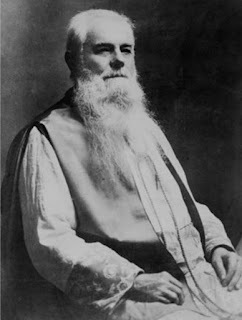Twice Captured and Stripped: Father Stephan's Bad Day Among the Confederate Cavalry
While perusing issues of the Journal& Courier from Lafayette, Indiana recently, I came across thisfascinating little story of a chaplain’s experience during the Battle of StonesRiver. It took a bit of digging to find out that the central character of thisstory was none other than Father Joseph Andrew Stephan, who at the time of thebattle was leading St. Boniface Church in Lafayette.
“The adventures of our worthyfriend Father Stephan in the recent battle of Murfreesboro furnish aninteresting chapter in the history of the great fight,” the Journal &Courier reported in their January 20, 1863, issue. “On Wednesday morning,in company with two other gentlemen, he started out on a mission of mercy andunconsciously got into the Rebel lines and was made a prisoner. He was taken tothe headquarters of the Rebel General [Joseph] Wheeler when, after stating hisvocation, he was released and furnished with a mule to regain our lines.”
“While pursuing his way union-ward,the mule landed him gently into a middle puddle and upon examination he foundthat a cannonball from one of our batteries had deprived the quadruped of twoof his pedestals,” the paper continued. “While deploring this accident, a partyof concealed Rebels again made a prisoner of him by whom he was treatedshamefully. They stripped him almost to a state of nudity, beat and kicked himmost unmercifully, at the same time relieving him of everything in the way ofvaluables.”
 Father Joseph Andrew Stephan of St. Boniface Parish in Lafayette, Indiana, shown here much later in life, was "very indignant" at the treatment he received from Confederate cavalrymen during the Battle of Stones River when the Hoosier priest was captured twice upon the battlefield. Rather than just live with the indignity, he threw his shoulder to the wheel and joined the army in May 1863.
Father Joseph Andrew Stephan of St. Boniface Parish in Lafayette, Indiana, shown here much later in life, was "very indignant" at the treatment he received from Confederate cavalrymen during the Battle of Stones River when the Hoosier priest was captured twice upon the battlefield. Rather than just live with the indignity, he threw his shoulder to the wheel and joined the army in May 1863. “Our troops coming in sight, theRebels, forcing the worthy chaplain to accompany them, beat a retreat,” thestory continued. “But upon Father Stephan giving out from sheer exhaustion,they mounted him upon a modern Rosinante without saddle or bridle and in thismanner reached the Rebel lines. He was eventually released and his entrée intoNashville, minus several important articles of wearing apparel, is described asanything but agreeable. He was very indignant at the treatment he receivedwhich, however, is on par with their previous actions.”
A few days later, no less apersonage that General William S. Rosecrans telegraphed the Bishop of theDiocese of Cincinnati asking that Father Stephan might be allowed to return tothe army. “Father Stephan is not only an invaluable aid in the hospital but isa first-class civil engineer,” the Journal & Courier reported. “He wasattached in this capacity to the staff of one of the revolutionary generals inBaden in 1848 and won some distinction.”
Joseph Andrew Stephan’s rootsstretched back to the Gissingheim in the Duchy of Baden-Wurttemberg where hewas born November 22, 1822, to Greek and Irish parents. Educated at Freiburgand Karlsruhe, he became an instructor in civil engineering at one of the universitiesbut became seriously ill and emigrated to the United States after the failedrevolution where completed his theological studies in Cincinnati. By theoutbreak of the Civil War, he was leading St. Boniface Parish in Lafayette. Anearly supporter of the war effort, Father Stephan lent his influence and gavehis support by both making speeches and encouraging enlistments, but also byvisiting his parishioners in the field. That’s how he came to his misadventuresat Stones River.
Perhaps still “indignant”at his recent treatment by the Confederate cavalry and flattered by Rosecrans’request (Rosey’s brother was also a Catholic priest in the Diocese ofCincinnati), Father Stephans was commissioned as a hospital chaplain on May 18,1863, and served until the end of the war, mustering out July 15, 1865. Hisobituary stated that “during the Civil War, Monsignor Stephan served as chaplainwith the forces of General Sheridan,” a fellow Catholic.
“He was one of the promoters ofCatholic missionary work among the Indians and in 1884 was appointed Directorof the Indian Mission by Cardinal Gibbons,” the obituary continued. “He waseminently successful in this work as is attested by the fact that during thisperiod he secured for the maintenance and support of the mission between $4-5million from the government and private sources. He was greatly loved by theIndians and his death will be mourned by them.” Monsignor Stephan passed away ofpneumonia September 12, 1901, in Washington, D.C. at the age of 79. He isburied at the Sisters of the Blessed Sacrament Cemetery in Bensalem,Pennsylvania.
Sources:
“Father Stephans,” Lafayette Journal & Courier(Indiana), January 20, 1863, pg. 3
“Father Stephens,” Lafayette Journal & Courier(Indiana), January 24, 1863, pg. 3
“Funeral of Mgr. Stephan,” Washington Post (District ofColumbia), September 16, 1901, pg. 8
Daniel A. Masters's Blog
- Daniel A. Masters's profile
- 1 follower



